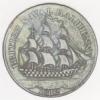-
Posts
1,057 -
Joined
-
Last visited
Reputation Activity
-
 grsjax reacted to Carlos Reira in Basswood vs Limewood
grsjax reacted to Carlos Reira in Basswood vs Limewood
They're related, same genus Tilia, but not the same. To say they are is misleading. The eminent European limewood has a history of being used for amazing carvings. Artists like Tilman Riemenschneider in the Gothic period and Grinling Gibbons in the Baroque did things with limewood that would be nearly impossible to do in American basswood. Basswood is no slouch, it being the wood used by most American carousel carvers, but the hardness and workability of limewood is superior, especially in smaller scale. They are both called "linden" sometimes but they are no more the same than butternut is walnut. There are at least two species of European lime, the small-leaved lime and the large-leaved lime, and it's possible one of them is better than the others. The Midwest company has done an amazing PR job for American basswood lumber. It was not much used historically.
-
 grsjax reacted to wefalck in Pomeranian Rahschlup 1846 by wefalck – 1/160 scale – single-masted Baltic trading vessel
grsjax reacted to wefalck in Pomeranian Rahschlup 1846 by wefalck – 1/160 scale – single-masted Baltic trading vessel
Thanks again to all for their encouragement !
**********************************************
Some small progress in the true and literary sense of the word:
Bilge-pump
Although not drawn in the original drawings, the ship must have had at least one bilge-pump. Such pumps would be logically located at the lowest part of the hull, usually somewhere close to the mast. As its location is not marked on the drawings, this is a bit of guess-work.
While Downton-pumps or similar existed already, when the Rahschlup was designed, they were comparatively expensive items. As the ship was built in a rather economically marginal context, it is more likely that a traditional wooden pump was installed, that could also be built and maintained with local materials and by local craftsmen, such as a blacksmith. Nicely rendered drawings for such pumps can be found, for instance, in the Danish naval yard archive.
Example for a bilge-pump from the former Danish naval yard (extract from G-2357-09)
The trunk would have been fashioned from a single tree, typically elm, that was bored out with the aid of spoon- or canon-drills in a sort of primitive boring-lathe. Iron bands kept it together and served as attachment points for the lever.
https://youtu.be/pj-XKqW29XE?si=9Q8RTsXOMxMuPPVN
Example for drilling of wooden pipes.
I made a rough sketch to fix the dimensions and settled on a height of 4 mm and a diameter of 1 mm, which would be 64 cm and 16 cm on the original respectively. The body was turned from a short length of acrylic rod, leaving the future bands as proud rings.
The mechanism is composed of four lengths of 0.2 mm tinned copper wire. The wire was first bent to shape and flattened at the appropriate places with a special kind of flattening pliers. Initially, I intended to solder the parts together, but they were just too small and flimsy, so I settled on cementing them together with lacquer. The procedure is a bit difficult to document photographically while doing it, so there are only pictures of the finished product.
The completed bilge-pump
I am afraid the translucent pump does not show very well in the photograph, but I generally only paint everything at the very end to avoid damage during repeated handling.
To be continued …
-
 grsjax reacted to wefalck in Pomeranian Rahschlup 1846 by wefalck – 1/160 scale – single-masted Baltic trading vessel
grsjax reacted to wefalck in Pomeranian Rahschlup 1846 by wefalck – 1/160 scale – single-masted Baltic trading vessel
Thanks for your initial interest!
*******************************
The basis for the model reconstruction
The model will not depict a specific ship, rather the reconstruction will be for the ‘type’, based on a set of drawings by a Joachim Möller (who was a builder in Rostock) dated to 1846 and preserved in the archives of the Rostock Maritime Museum (https://schifffahrtsmuseum-rostock.de). It is not known, to which ship, as they were not named, nor was a client indicated on the drawings.
Sail plan and lines drawings of a Rahschlup drawn by Joachim Möller, dated 1846, Schiffahrtsmuseum Rostock.
They follow the practice of the time and give line and body plans as well as side elevation/longitudinal section and a sail-plan. This allows to reconstruct much of the deck-layout and the dimensioning of the visible woodwork. The sail-plan also contains a table with the spar dimensions.
Much of the details of the deck, the rigging and other fittings will have to be reconstructed from contemporary paintings and photographs of similar craft that survived into the late 19th or even into our times.
A valuable source of information are the books by Friis-Pedersen (1980 and1983), and Funch (1833 and 1846). Interestingly, the water-colours by Friis-Pedersen reproduced above show a Rahschlup virtually identical to that of the plans by Joachim Möller, but I doubt that Friis-Pedersen had access to these drawings, which were located in the GDR at the time.
General information on contemporary building practice in Germany can be found in Klawitter (1835) and Steinhaus (1858), which bracket the time, when this Rahschlup was designed. Masting and rigging details can be obtained from Bobrik (1848), Biddlecombe (1848), and Steinhaus (1869). The two Danish jagt measured by Nielsen (1973) give details on dimensions of scantlings and other parts, which are useful for upscaling. One should also not forget the detailed drawings of a Danish jagt in the ‘Souvenirs de la Marine’ by Pâris.
Other more or less contemporary (text)books on shipbuilding and rigging will be also consulted, but with caution, as they typically reflect the practice in larger ocean-going vessels. However, tables on spar and rigging proportions are still useful.
Various useful resources
No Web-site covering this type of coastal craft could be found yet (apart from my own).
There are, however, some sites that feature a Jacht, jagt (Danish), jakt (Swedish) or slup (Norwegian, Swedish) under restauration. The most interesting site was the one documenting the restoration of the small Norvegian slup RUTH (1854, https://www.sluppenruth.dk), however the many photos of the process seem to have disappeared from their Web-site since I downloaded them five years ago. The restoration project for the Danish Jagt 'JENSINE AF HADERSLEV' (https://www.jensine.dk) from 1852 is also interesting, because the photographs show many original details of such and the steps of reconstructing unsound or missing parts. It should be noted that all these restorations altered the original deck-layouts with a view to accommodate the needs of cruising vessels and modern safety at sea requirements.
A replica of a Danish Jagt has been constructed at the museum shipyard of Flensburg on the basis of the lines of the DE FIRE BRØDRE (1794), whose lines are reproduced in NIELSEN (1973). Unfortunately, their Web-site does not give any details on this project beyond the launch that took place in 2009. Pictures of her construction can be seen here:https://www.arbeitskreis-historischer-schiffbau.de/mitglieder/ontour/flenswerft/.
The Altonaer Museum in Hamburg has a fine collection of models of small 19th century merchant sailing ships. These models were constructed in 1/24 scale between 1909 and 1912 from plans in the museum collection and plans on loan from various shipyards of the region (Timmermann, 1974) by a boatbuilder, a blockmaker and a sailmaker. While these models are not contemporary to their prototypes, their builders were presumably close enough to the time to have reproduced reasonably well the then current practices of construction and rigging. Below are two pictures of the Schlup ELBE (1836). More pictures of these models can found at https://www.maritima-et-mechanika.org/maritime/hamburg/altona.html.
Model of the Schlup ELBE (1836) in 1/24 scale. Built by D. Behrens in Schulau (near Hamburg) for Hans Oestmann (Inv. Nr. AB 1813, Altonaer Museum, Hamburg)
Over the years more and more museum holdings in terms of drawings and paintings have been digitised and made available through the Internet, namely those of the (maritime) museums of Denmark, Norway, and Sweden. This allowed to consult numerous paintings of Norvegian and Swedish slups and Danish jagts.
Literature
As for graphical resources, most of the literature listed below has become available as digital copies over the past 20 years, which allows to consult even rather rare books remotely.
BIDDLECOMBE, G. (1848): The Art of Rigging.- 155 p., Salem, Ma. (Reprint 1990 by Dover Publication, New York).
BOBRIK, E. (1846): Handbuch der praktischen Seefahrtskunde.- Vol. 1-7: 2688 p., 50 pl. Zürich/Hamburg (Julius Fröbel & Co./Hoffman & Campe).
Chapman, H. Af (1768): Architectura Navalis Mercatoria.- 103 pp., Rostock (Reprint 1968 at VEB Verlag Hinstorff).
Fleischfresser, K., Hoffmann, R. (1975): Segler von Haff und Bodden. Pommersche Küstenschiffahrt.- 96 pp., Hamburg-Norderstedt (Verlag Egon Heinemann).
[Friis-Pedersen, J.] (1980): Sejlskibe - Danskbyggede traeskibbe opmålt, tegnet og fotograferet.- Handels- og Søfahrtsmuseets på Kronborg Søhistoriske Skrifter IX: 107 pp., København (Høst & Søn).
[Friis-Pedersen, J.] (1983): Sejlskibe - Nordiske fartøjer opmålt, tegnet og fotograferet.- Handels- og Søfahrtsmuseets på Kronborg Søhistoriske Skrifter XI: 96 pp., København (Høst & Søn).
Funch, D.H. (1833): Praktisk Skibbyggerie. Et Forsøg.- 76 folding (some are quite large) lithographed plates, including 28 in full color & many others tinted or heightened in color. 76 pp., 1 leaf of errata; 64 pp.; 223, [4] pp., 1 leaf of errata. Three parts in one vol., Kjøbenhavn (Luno & Schneider).
Funch, D.H. (1843): Afhandling om coffardiskibes constructionen. Et Forsøg.- 2 bd. (6) + 74 + (2) +92 p., 17 fold. plancher, 9 tabeller og 3 blade med forklarende tekst, Kjøbenhavn (trykt paa Forfatterens Forlag).
Funch, D.H. (1846): Dansk Marine-Ordbog, 1ste Part.- 170 pp. + 67 Pl., Kjøbenhavn (Forfatterens Forlag, reprint 1976 by Høst & Søn, Copenhagen).
Gøthche, M. (1980): Sluppen Ruth – rapport om restaurering af Nationalmuseets slup..- Maritim Kontakt, 1: 59-77, København.
Klawitter, K.G. (1835): Vorlegeblätter für Schiff-Bauer für die Königlichen Schiffbau-Schulen.- 40 pp., Berlin (Petsch, reprint 1978 by H. Hamecher, Kassel).
Monrad Møller, A. (1988): Jagt og skonnert. Studier i den danske provinssøfart i tiden fra 1814 til 1864.- 273 p., København (Forlaget Falcon).
Nielsen, C. (1973): Danske Bådtyper.- 152 pp., København (Høst and Søns Forlag).
Olszak, H. (2014): Hölzerne Fischereiboote der südlichen Ostseeküste. Vermessene Relikte und rekonstruierte Zeitzeugen.- 276 p., Henningsdorf (Eigenverlag Michael Sohn/Sohn-Art).
Rudolph, W. (1958): Die letzten hölzernen Frachtfahrzeuge der kleinen Küstenfahrt auf Rügen (m. Pers.-Literaturangaben u. Abb.).- Balt. Stud., NF, 45: 137-43.
Rudolph, W. (1958): Die Schiffstypen der ländlichen Frachtschiffahrt in den Gewässern der Insel Rügen.- Dt. Jb. f. Volksk., IV: , Berlin (Ost).
Rudolph, W. (1962): Rügischer Schiffbau auf den Werften zu Seedorf.- Greifswald-Stralsunder Jb.: ?.
Rudolph, W. (1966): Handbuch der volkstümlichen Boote im östlichen Niederdeutsch-land.- 150 pp., Berlin (Akademie Verlag).
Rudolph, W. (1969): Segelboote der deutschen Ostseeküste.- 145 pp., Berlin (Akademie Verlag).
Steinhaus, C.F. (1858): Die Schiffbaukunst in ihrem ganzen Umfange – I. Theil: Die Theorie der Schiffbaukunst, II. Theil: Die Schiffbaukunst in der Praktik.- 158+170 pp. + 4 Tafeln, Hamburg (P. Salomon & Co., reprint 1977 by Horst Hamecher, Kassel).
Steinhaus, C.F. (1869): Die Construction und Bemastung der Segelschiffe.- 137 pp., Hamburg (L. Friedrichsen & Co., reprint 1977 by Horst Hamecher, Kassel).
Szymanski, H. (1929): Zur Geschichte der schleswig-holsteinischen Jachten im 19. Jahrhundert.- Der Kleinschiffbau – Z. f. Gebrauchs- u. Sportfahrzeuge aller Art, ?: 209f., Berlin.
Szymanski, H. (1929): Die Segelschiffe der deutschen Kleinschiffahrt.- Pfingstblätter des Hansischen Geschischtsvereins, Bl. XX, 81+XXI pp., Hamburg.
Szymanski, H. (1934): Deutsche Segelschiffe.- Veröff. Inst. f. Meereskunde, N.F. B, H. 10: 167 pp. + 92 Taf., Berlin.
Timmermann, G. (1974): Das Schiffbauhandwerk.- Schausammlungen des Altonaer Museums, H. 1: 93 p., Hamburg (Altonaer Museum).
To be continued
-
 grsjax reacted to wefalck in 2x2x24 boxes for organizing wood strips
grsjax reacted to wefalck in 2x2x24 boxes for organizing wood strips
Can't you make such boxes yourself? You could fashion them as open trays right away.
I don't know in what sizes cardboard is sold in the USA, but if there are sufficient lengths, one can cut strips of the desired width and assemble them with old-fashioned packaging tape (the one that needs to be wetted, not the self-adhesive one, which looses its tackiness over the years) or perhaps duct-tape.
I for myself made a wall-hanging rack with horizontal shelves, so that short pieces can be kept at the front. Not an ideal solution, but the wall above my machines was the only place I had and here in Europe all materials are sold in 1 m lengths.
-
 grsjax reacted to SardonicMeow in Sultana by SardonicMeow - FINISHED - Model Shipways - Scale 1:64
grsjax reacted to SardonicMeow in Sultana by SardonicMeow - FINISHED - Model Shipways - Scale 1:64
Having reached the end, it's hard to know what to write.
This has been a build like no other, and one where I created a lot of challenges for myself. The main goal was to expand my modeling experience and to try out some unconventional techniques. That goal, I think, was achieved. If I could go back in time and give myself advice, I would have recommended making this a fully scratch build and executing it in 1:48 scale (or even 1:32). I have read that when Model Shipways releases a new POB Sultana, it will be in 1:48 scale, and I can understand why. Working at 1:64 has been the biggest challenge, and many times I wished I didn't have to work with such small blocks and other components. I'm also disappointed by the sloppiness of some of my work, especially the painting, and the lack of crisp details on some of the components that I made. (And that big glob of dried glue, that I've been strategically hiding when I take pictures.) I still have lots of room for improvement.
Thank you to everyone who has been following along with this build. Your comments and encouragement have been much appreciated. I hope to see you when I start my next one.
Moderators, if you are reading this, please mark this build log FINISHED.
-
 grsjax reacted to MrBlueJacket in Stranded copper wire for standing rigging? Bluejacket Friendship sloop 1900
grsjax reacted to MrBlueJacket in Stranded copper wire for standing rigging? Bluejacket Friendship sloop 1900
Yes they did use wire. 3mm dia wire is VERY strong. personally, I use CA when I cut the wire so it doesn't unravel. To fasten, I loop the wire through an eye, when use a 1/4" piece of 1/16 aluminum tube to crimp the wire in place.
Nic
-
 grsjax reacted to Y.T. in Tapering Masts and Arms the easy way
grsjax reacted to Y.T. in Tapering Masts and Arms the easy way
Can you please provide more details? I didn’t understand.
-
 grsjax reacted to em_fo in Hurricane Island Pulling Boat by em_fo - Laughing Whale - 1:24 - first build
grsjax reacted to em_fo in Hurricane Island Pulling Boat by em_fo - Laughing Whale - 1:24 - first build
Totally new to model boat building and will be thankful for anyone who can follow along and lend tips/answers to questions I may have along the way!
-
 grsjax got a reaction from Matle in Sutton Hoo Ship
grsjax got a reaction from Matle in Sutton Hoo Ship
Interesting paper on the reconstruction of the lines and construction details of the Sutton Hoo ship.
https://eprints.soton.ac.uk/438414/1/Tanner_etal_2020_DigitalReconstructionOfTheSuttonHooShip_AcceptedManuscript.pdf
-
 grsjax reacted to Richard Braithwaite in Japanese Oak
grsjax reacted to Richard Braithwaite in Japanese Oak
Has anyone tried this? apparently it grows very slowly and has a very fine grain. I recently attended a presentation by David Hulse in Dartmouth. He has spent most of his life researching and building exceptional models of Atmospheric Steam engines, which he has donated to our local museum in Dartmouth. They are built to a scale of 1:12. He has used Japanese Oak for the wooden components and it looks very effective at this scale.
He was Chief Engineer at Royal Doulton and used his knowledge and expertise to develop a process (and build the machinery) for producing thousands of 1:12 scale bricks using 17th Century methods for his models.
Worth checking out his models at:
The Hulse Collection - Dartmouth Museum
-
 grsjax reacted to Johnny Mike in Tapering Masts and Arms the easy way
grsjax reacted to Johnny Mike in Tapering Masts and Arms the easy way
All the information I have seen on tapering dowels for masts and arms
is by a lot of hand sanding or turning. I have done it this way myself and it was time consuming and I had to guess at the taper for continuity.
And being a novice it was difficult to get matching results.
I tried something that works to get a consistent taper quick and easy.
I took my disc sander and clamped on a guide to the angle I wanted and simply hand fed the dowel in while rotating it by hand. I had a perfect taper from 12mm diameter to 9mm in diameter in 8". Exactly what I wanted in just a few minutes.
Maybe this is common practice for the expert builders but being a novice builder is was an amazing discovery for me.
-
 grsjax got a reaction from sheepsail in Sutton Hoo Ship
grsjax got a reaction from sheepsail in Sutton Hoo Ship
Interesting paper on the reconstruction of the lines and construction details of the Sutton Hoo ship.
https://eprints.soton.ac.uk/438414/1/Tanner_etal_2020_DigitalReconstructionOfTheSuttonHooShip_AcceptedManuscript.pdf
-
 grsjax got a reaction from thibaultron in Sutton Hoo Ship
grsjax got a reaction from thibaultron in Sutton Hoo Ship
Interesting paper on the reconstruction of the lines and construction details of the Sutton Hoo ship.
https://eprints.soton.ac.uk/438414/1/Tanner_etal_2020_DigitalReconstructionOfTheSuttonHooShip_AcceptedManuscript.pdf
-
 grsjax got a reaction from Kenchington in Sutton Hoo Ship
grsjax got a reaction from Kenchington in Sutton Hoo Ship
Interesting paper on the reconstruction of the lines and construction details of the Sutton Hoo ship.
https://eprints.soton.ac.uk/438414/1/Tanner_etal_2020_DigitalReconstructionOfTheSuttonHooShip_AcceptedManuscript.pdf
-
 grsjax got a reaction from cotrecerf in Sutton Hoo Ship
grsjax got a reaction from cotrecerf in Sutton Hoo Ship
Interesting paper on the reconstruction of the lines and construction details of the Sutton Hoo ship.
https://eprints.soton.ac.uk/438414/1/Tanner_etal_2020_DigitalReconstructionOfTheSuttonHooShip_AcceptedManuscript.pdf
-
 grsjax reacted to Chuck in Syren Ship Model Company News, Updates and Info.....(part 2)
grsjax reacted to Chuck in Syren Ship Model Company News, Updates and Info.....(part 2)
1/2" scale...
It will make a great desk top model. I am sure you guys have seen the various contemporary models out there. The "Box" or display varies. But they are all quite nice/
-
 grsjax reacted to Cathead in Viking longship by Cathead - FINISHED - Dusek - 1:35
grsjax reacted to Cathead in Viking longship by Cathead - FINISHED - Dusek - 1:35
After a long and complex scratchbuild (the American Missouri River steamboat Arabia), I felt the need for something a little more relaxing (i.e., with instructions and someone else's planning work). Being of primarily Norwegian/British/Irish descent, I've long been interested in the Anglo-Saxon-Viking era and a ship from that period makes a very distinct project from my core interest in American riverboats. So I settled on this Dusek longship, based on one of the five vessels found at Skuldelev in Denmark. The fact that the original was built in Ireland adds extra interest for me, and I've read good things about Dusek kits. From the Dusek site:
Dusek makes kits for three styles of Viking ship: this longship, the Gokstad ship, and a knarr. All three are offered in 1:72 and 1:35; I chose the latter as I was interested in the chance to include some extra detail possible at this scale. As far as I can tell, there isn't a single build log for this kit on MSW, so hopefully this is of use to others. Here are all the logs for Dusek Viking ships that I could find on MSW (please alert me if I've missed one):
Gokstad Viking Ship by jack.aubrey - Dusek Ship Kits - 1:35 Scale
Gokstad Viking Ship by Seventynet - Dusek Ship Kits - FINISHED - 1:35 Scale
Gokstad Viking Ship by Dr PS - Paul Schulze - Dusek Ship Kits - 1:35 Scale
Viking Knarr by Daryl - FINISHED - Dusek - Scale 1:72
Viking Longship by Binho - Dusek - Scale 1:72
I don't intend to build this as an exact replica of the original but rather use it as a base to adapt the vessel to have certain features I find interesting. For example, I've done some reading on various ways shields were hung/displayed and want to modify this to use a shield rack (as was found on a different Skuldelev ship). I'm also going to replace some of the kit wood with material harvested and milled by myself. There are other possibilities I'm toying with that may come up in good time. I haven't started on the kit yet, but wanted to announce the build and welcome anyone who's interested in these vessels to follow and offer me advice as I take on something very different from my normal milieu.
-
 grsjax reacted to catopower in Woody Joe kits
grsjax reacted to catopower in Woody Joe kits
I've bought way more Woody Joe kits that I care to admit, all from Kazunori Morikawa's online shop Zootoyz.jp, or his newer site https://www.japan-wooden-model-kits-zootoyz.shop. I don't really understand why he started the second online shop, I think due to some server problems he was having with the first.
Anyway, prices are MUCH better than most that you'll find on Amazon or Ebay, and his service is excellent!
-
 grsjax reacted to kljang in Woody Joe kits
grsjax reacted to kljang in Woody Joe kits
I visited Woody Joe in Shizuoka and met the owner, Mr Tsuneki, and the manager, his daughter, Ms Yukari Gojo. I did an article on my visit for Model Boats magazine in the UK. I have included the .pdf of the article.
Woody Joe is a specialist manufacturer of wooden kits (the main business is wood milling) and everything is done in house and they use only the best materials. The wood is imported from SE Asia or domestic woods from Japan (e.g., hinkoi cypress) which is expensive in Japan. The kit selection is based on what the Japanese market prefers as opposed to making what is popular elsewhere. Each kit part is picked by hand and double checked.
Kit design is excellent and multimedia. Wood, paper, metal, etch….. whatever works best. Their kits are very popular in Japan and Ms. Gojo says that they cannot keep up with local demand, and they do not market directly overseas. Instead there are resellers. You can buy directly from them, cutting out the middleman. English is not their first language so patience and respect are key if buying direct or contacting them by email.
I have their Nippon Maru and I-400 kit, and my wife a temple. Beautifully produced and beautiful when finished. Some of their Edo era Japanese ships were designed by modellers from The Rope Tokyo model building club.
The price is a function of specialist timber costs, quality assurance and the high cost of care to ensure quality control.
Cheers,
Kerry
044 LAND OF THE RISING SUN edited.PDF
-
 grsjax reacted to catopower in Woody Joe kits
grsjax reacted to catopower in Woody Joe kits
Not really sure. It's not a huge company, but they're producing a large number of products. Might have something to do with providing good standard of living to the employees. I don't think they sell huge volumes of kits.
I used to think their kits were expensive, but with the exchange rate as it is, I feel less that way now. I've bought many of their kits in the $200-$250 range.
Which kits are you looking at that you consider expensive?
-
 grsjax reacted to Kenchington in Carvings
grsjax reacted to Kenchington in Carvings
I would say, in general, no.
They were usually permanently fastened in place and anyway were thought to be essential to the function of the vessel. That seems odd to a modern mind but our notions of cause-and-effect date from the Enlightenment. It took a long while for practical seamen, shipwrights and so forth to see that light, so well into the 18th Century men supposed that the carvings were as vital to the power of a warship as her guns were. (Considering that scaring the other guy into submission was half the point, the idea wasn't entirely wrong anyway.)
For Nonsuch, fighting wasn't the objective but the grandeur of the Company was. The carvings were a projection of that.
Trevor
-
 grsjax reacted to John Ruy in Looking for ideas for work area
grsjax reacted to John Ruy in Looking for ideas for work area
Hi, Chris
My approach was to buy two work bench kits from Home Depot and configure a corner bench with a Lazy Susan attached in the corner. I then built a drawing board on the opposite return.
works well for my confined space in my basement.
-
 grsjax reacted to Paul Le Wol in Looking for ideas for work area
grsjax reacted to Paul Le Wol in Looking for ideas for work area
Hi Chris, I have three work tables. One for drawings, one for the build board and one for fabricating. I always stand while working so the tables are all 42” high which is about elbow height for me. The build board and fabricating tables sit in the middle of the room so that all sides are accessible. If I get tired of standing I have a roll around drafting chair with the seat sitting 30” off the floor. I find that this works for me because I don’t like having to climb out of a chair if I have to go get something which is quite often. I never put anything in cupboards because once the door is closed I can’t remember where it is or if I even have such a thing. Each table has an led shop light hanging over it and an articulating magnifying light clamped to it. And lastly I invested in a good shop vac that doesn’t scream when you turn it on. Good luck with your new shipyard 👍
-
 grsjax got a reaction from SiriusVoyager in Which kit would be better for me to make next, MS Mayflower or the Occre Cala Esmeralda
grsjax got a reaction from SiriusVoyager in Which kit would be better for me to make next, MS Mayflower or the Occre Cala Esmeralda
Seems like everyone has built the Mayflower. Go with the Occre Cala Esmeraldae for something different and interesting.
-
 grsjax got a reaction from alde in Jig for planing planks?
grsjax got a reaction from alde in Jig for planing planks?
I think this has been mentioned here before but I will go ahead and mention it again. At least a few companies sell a fixture to hold a model by the keel to make it easier to work on.
This one is sold by Mantua. They work really well for trimming planks.








